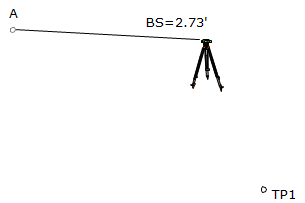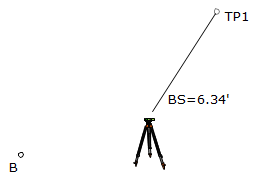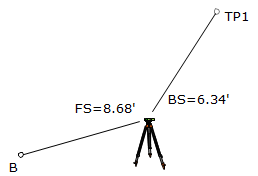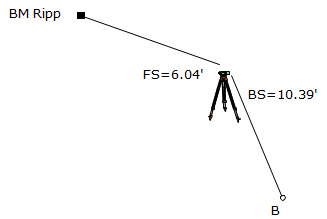C. Differential Leveling Notes
1. General
Data are recorded and computations are done immediately so when the network readings are done, so are the elevations.
Readings and computations are recorded on the left plate of the field book page and support information on the right, Figure C-1.
 |
| Figure C-1 Fieldnotes Layout |
Although at first glance differential leveling notes may appear a little complicated, they are relatively simple and reflect the leveling process. It is important that running computations be done in the field as data are collected to minimize mistakes. Should a mistake be found, the equipment and crew are able to remeasure immediately.
2. Example
A differential level network is run from BM Ripp through A, TP1, B, and closes back on BM Ripp, Figure C-2.
The elevation of BM Ripp is 820.12 ft.
 |
| Figure C-2 Example Level Circuit |
The BS and FS numbers shown in Figure C-2 are the Backsight (BS) and Foresight (FS) readings respectively at each instrument set up. These are shown only for example purposes - this is not how readings are recorded in the field.
The measurement and computation sequence carries an elevation from the BS point through the instrument to the FS point, Figure C-3. The notes are recorded and reduced reflecting this process.
 |
| Figure C-3 Process |
Click here for a video of the example.
a. Set up notes
(1) Enter column headings on the left plate
| Point | BS(+) | EI | FS(-) | Elev | |
(2) Enter the benchmark information
A closed circuit must begin on a known elevation. Enter the name and elevation of the first point, in this case, BM Ripp.
| Point | BS(+) | EI | FS(-) | Elev | |
| BM Ripp | 820.12 | ||||
b. Run line from BM Ripp to A
(1) Set up the instrument between BM Ripp and A.
 |
| Figure C-4 |
(2) Skip a line in the notes and enter the point name.
| Point | BS(+) | EI | FS(-) | Elev | |
| BM Ripp | 820.12 | ||||
| A | |||||
(3) Take a BS reading on the benchmark
A level circuit always begins with a BS reading.
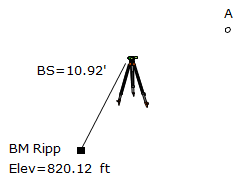 |
| Figure C-5 |
The BS reading is recorded in the BS(+) column on the row for BM Ripp.
Compute and record EI. The EI is entered in the EI column on the row between BM Ripp and A (the instrument is between the two points).
EI = 820.12+10.92 = 831.04
| Point | BS(+) | EI | FS(-) | Elev | |
| BM Ripp | 10.92 | 820.12 | |||
| 831.04 | |||||
| A | |||||
(4) Take a FS reading on A.
 |
| Figure C-6 |
The FS reading is recorded in the FS(-) column on the row for A.
The elevation of A is computed and recorded in the Elev column on the row for A.
ElevA = 831.04-3.42 = 827.62
| Point | BS(+) | EI | FS(-) | Elev | |
| BM Ripp | 10.92 | 820.12 | |||
| 831.04 | |||||
| A | 3.42 | 827.62 | |||
The elevation of A has now been determined so the instrument can be moved.
Notice the data recording and computation flow from BM Ripp to A:
BS reading is added to an elevation to obtain the EI.
FS reading is subtracted from the EI to obtain an elevation.
c. Run line from A to TP1
(1) Set up the instrument between points A and TP1.
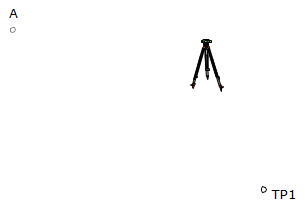 |
| Figure C-7 |
(2) Skip a line in the notes and enter the point name
| Point | BS(+) | EI | FS(-) | Elev | |
| BM Ripp | 10.92 | 820.12 | |||
| 831.04 | |||||
| A | 3.42 | 827.62 | |||
| TP1 | |||||
(3) Take a BS reading on A
|
|
| Figure C-8 |
Record BS reading in the BS(+) column on the row for A.
Compute and record EI:
827.62+2.73 = 830.35
| Point | BS(+) | EI | FS(-) | Elev | |
| BM Ripp | 10.92 | 820.12 | |||
| 831.04 | |||||
| A | 2.73 | 3.42 | 827.62 | ||
| 830.35 | |||||
| TP1 | |||||
(4) Take a FS reading on TP1
|
|
| Figure C-9 |
The FS reading is recorded in the FS(-) column on the row for TP1
The elevation of TP1 is computed and recorded in the Elev column on the row for TP1.
ElevTP1 = 830.35-12.28 = 818.07
| Point | BS(+) | EI | FS(-) | Elev | |
| BM Ripp | 10.92 | 820.12 | |||
| 831.04 | |||||
| A | 2.73 | 3.42 | 827.62 | ||
| 830.35 | |||||
| TP1 | 12.28 | 818.07 | |||
The elevation of TP1 has now been determined so the instrument can be moved to its next location.
d. Run line from TP1 to B
(1) Set up the instrument between points TP1 and B.
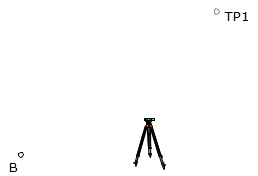 |
| Figure C-10 |
(2) Skip a line in the notes and enter the point name.
| Point | BS(+) | EI | FS(-) | Elev | |
| BM Ripp | 10.92 | 820.12 | |||
| 831.04 | |||||
| A | 2.73 | 3.42 | 827.62 | ||
| 830.35 | |||||
| TP1 | 12.28 | 818.07 | |||
| B | |||||
(3) Take a BS reading on TP1
|
|
| Figure C-11 |
Record BS reading in the BS(+) column on the row for A.
Compute and record EI:
818.07+6.34 = 824.41
| Point | BS(+) | EI | FS(-) | Elev | |
| BM Ripp | 10.92 | 820.12 | |||
| 831.04 | |||||
| A | 2.73 | 3.42 | 827.62 | ||
| 830.35 | |||||
| TP1 | 6.34 | 12.28 | 818.07 | ||
| 824.21 | |||||
| B | |||||
(4) Take a FS reading on B
|
|
| Figure C-12 |
The FS reading is recorded in the FS(-) column on the row for B.
The elevation of B is computed and recorded in the Elev column on the row for B.
ElevB = 824.41-8.68 = 815.73
| Point | BS(+) | EI | FS(-) | Elev | |
| BM Ripp | 10.92 | 820.12 | |||
| 831.04 | |||||
| A | 2.73 | 3.42 | 827.62 | ||
| 830.35 | |||||
| TP1 | 6.34 | 12.28 | 818.07 | ||
| 824.21 | |||||
| B | 8.68 | 815.73 | |||
B is the final unknown elevation so technically all the elevations have been determined. However, stopping now would result in an open circuit with no opportunity to determine if any errors were made. For that reason, the circuit is closed back on BM Ripp by determining its elevation from B.
e. Run line from B to BM Ripp
(1) Set up the instrument between points TP1 and B.
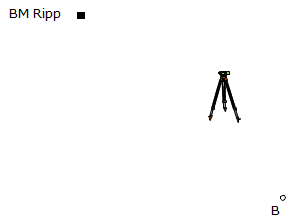 |
| Figure C-13 |
(2) Skip a line in the notes and enter the point name
| Point | BS(+) | EI | FS(-) | Elev | |
| BM Ripp | 10.92 | 820.12 | |||
| 831.04 | |||||
| A | 2.73 | 3.42 | 827.62 | ||
| 830.35 | |||||
| TP1 | 6.34 | 12.28 | 818.07 | ||
| 824.21 | |||||
| B | 8.68 | 815.73 | |||
| BM Ripp | |||||
(3) Take a BS reading on B
|
|
| Figure C-14 |
Record BS reading in the BS(+) column on the row for B.
Compute and record EI:
815.73+10.39 = 826.12
| Point | BS(+) | EI | FS(-) | Elev | |
| BM Ripp | 10.92 | 820.12 | |||
| 831.04 | |||||
| A | 2.73 | 3.42 | 827.62 | ||
| 830.35 | |||||
| TP1 | 6.34 | 12.28 | 818.07 | ||
| 824.21 | |||||
| B | 10.39 | 8.68 | 815.73 | ||
| 826.12 | |||||
| BM Ripp | |||||
(4) Take a FS reading on BM Ripp
|
|
| Figure C-15 |
The FS reading is recorded in the FS(-) column on the row for BM Ripp.
The elevation of BM Ripp is computed and recorded in the Elev column on the row for BM Ripp.
ElevBM Ripp = 826.12-6.04 = 820.08
| Point | BS(+) | EI | FS(-) | Elev | |
| BM Ripp | 10.92 | 820.12 | |||
| 831.04 | |||||
| A | 2.73 | 3.42 | 827.62 | ||
| 830.35 | |||||
| TP1 | 6.34 | 12.28 | 818.07 | ||
| 824.21 | |||||
| B | 10.39 | 8.68 | 815.73 | ||
| 826.12 | |||||
| BM Ripp | 6.04 | 820.08 | |||
Note that the field notes start with a BS on BM Ripp and ends with a FS on Ripp.
The EIs and Elevs were computed as the respective readings were made.
Upon taking the final FS reading, the closing elevation is immediately computed so it can be compared against the known elevation. Although there is a difference between the closing and beginning elevations of BM Ripp, we won’t concern ourselves with the misclosure amount until after we check our math.
f. Perform a page check
The purpose of a page check is to verify the running computations. To arrive at the closing elevation of BM Ripp, we started with its known elevation, added the BS readings, then subtracted the FS readings.
To perform a page check:
- Sum the BS and FS columns,
- Add the BS sum to the beginning elevation,
- Subtract the FS sum
The result should be the end elevation on the page.
| Point | BS(+) | EI | FS(-) | Elev | |
| BM Ripp | 10.92 | 820.12 | |||
| 831.04 | |||||
| A | 2.73 | 3.42 | 827.62 | ||
| 830.35 | |||||
| TP1 | 6.34 | 12.28 | 818.07 | ||
| 824.21 | |||||
| B | 10.39 | 8.68 | 815.73 | ||
| 826.12 | |||||
| BM Ripp | 6.04 | 820.08 | |||
| Sums: | 30.38 | 30.42 | |||
| Start elev | 820.12 | ||||
| ΣBS = | +30.38 | ||||
| 850.50 | |||||
| ΣFS = | -30.42 | ||||
| End elev | 820.08 | check | |||
If the end elevations differ, that means there's a math mistake somewhere on the page.
The page check should be done in the field immediately. It can be recorded at the bottom of the left plate or, to allow more data recoding room, at the bottom of the right plate.
A page check will only identify a math error - it will not find a reading or recording error. For example, if there is a 5 ft error in a one of the readings, the closing elevation will miss the known elevation by about 5 ft; the page check will also miss by the same amount.
3. Multiple Pages
If a circuit is long enough it may require more than two pages. Each page begins with a BS on a starting elevation and ends with an FS establishing an ending elevation. The ending elevation on the first page is the starting elevation on the second page, and so on as necessary.
Each page has its own page check which should be done immediately upon page completion. Since the end elevation on one page is the start elevation on the next, a math error on one page affects all elevations on subsequent pages.
For example, the notes for the circuit shown in Figure C-16 covers two pages.
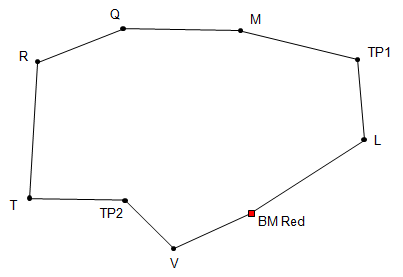 |
| Figure C-16 Larger Level Circuit |
The first page ends with a FS on R establishing its elevation:
| First page | |||||
| Point | BS(+) | EI | FS(-) | Elev | |
| BM Red | 9.73 | 893.56 | |||
| 903.29 | |||||
| L | 10.39 | 2.88 | 900.41 | ||
| 910.80 | |||||
| TP1 | 6.02 | 8.26 | 902.54 | ||
| 908.56 | |||||
| M | 11.35 | 1.63 | 906.93 | ||
| 918.28 | |||||
| Q | 3.23 | 1.88 | 916.40 | ||
| 919.63 | |||||
| R | 5.66 | 913.97 | |||
| ΣBS = | 40.72 | ΣFS = | 20.31 | ||
The page check is:
| Start elev: | 893.56 | |
| ΣBS = | +40.72 | |
| 934.28 | ||
| ΣFS = | -20.31 | |
| End elev | 913.97 | check |
The next page starts at R with its elevation from the previous page. The circuit continues beginning with a BS on R to carry the elevation forward:
| Second page | |||||
| Point | BS(+) | EI | FS(-) | Elev | |
| R | 1.09 | 913.97 | |||
| 915.06 | |||||
| T | 5.96 | 7.69 | 907.37 | ||
| 913.33 | |||||
| TP2 | 3.87 | 9.03 | 904.30 | ||
| 908.17 | |||||
| V | 1.03 | 10.81 | 897.36 | ||
| 898.39 | |||||
| BM Red | 4.78 | 893.61 | |||
| ΣBS = | 11.95 | ΣFS = | 32.31 | ||
The page check is:
| Start elev: | 913.97 | |
| ΣBS = | +11.95 | |
| 925.92 | ||
| ΣFS = | -32.31 | |
| End elev | 893.61 | check |
Note that if the first page had a one foot math error that wasn’t caught with a page check, then all the elevations on the second page would be off one foot (they could still be correct relative to each other). Further, since all its elevations are off the same amount, a page check of the second page would still check out OK. That’s because the math error occurred before the second page. Page checks should be done in the same order the pages are compiled.
Always: perform the page check immediately upon page completion.
